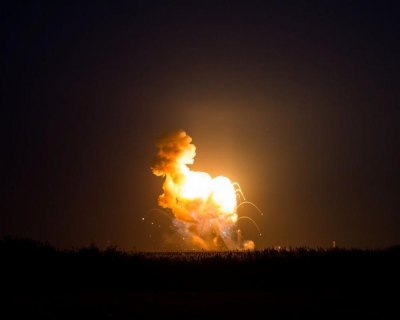In Brief: NASA to probe rocket explosion

Orbital’s Antares rocket was to carry 5,000 pounds of NASA cargo aboard the company’s Cygnus spacecraft. But immediately after the 6:22 p.m. takeoff from the Mid-Atlantic Regional Spaceport at NASA’s Wallops Flight Facility in Virginia, the rocket exploded.
The company's statement said there were no casualties. Orbital has formed an "anomaly investigation board, which will work in close coordination with all appropriate government agencies" to determine why the rocket failed. The company, based in Dulles, Virginia, also planned a conference call with investors Oct. 29.
NASA will move toward the next scheduled launch once investigators understand the accident, said William Gerstenmaier, associate administrator of NASA’s Human Exploration and Operations Directorate, in a statement. "The crew of the International Space Station is in no danger of running out of food or other critical supplies," the statement added.
The launch had been set for Oct. 27 but was scrubbed because a boat came inside the range safety zone southwest of the launchpad.
A sailboat about 26 feet long entered the hazard zone -- 1,400 square miles off the coast of Wallops Island along the Eastern Shore of Virginia -- early in the launch count. Aircraft detected the boat and hailed it several times, but there was no response.
In 2008, NASA awarded two contracts -- one to Orbital and another to Space Exploration Technologies Corp. (SpaceX) of Hawthorne, California -- for commercial cargo resupply services to the International Space Station. NASA ordered eight flights valued at about $1.9 billion from Orbital and 12 flights valued at about $1.6 billion from SpaceX, according to a NASA news release.
NASA SEEKS PARTNERSHIPS FOR SPACE TRAVEL: NASA wants to use public-private partnerships to develop three capabilities for space exploration.
The development of three key areas – advanced propulsion, habitation and small satellites deployed from the Space Launch System – is critical to the next step for human spaceflight. This work will use the proving ground of space around the moon to develop technologies and advance knowledge to expand human exploration into the solar system.
State-of-the-art solar electric propulsion technology currently employed by NASA generates less than 5 kilowatts. NASA wishes to advance the technology to 50- to 300-kilowatt systems to meet the needs of a variety of mission concepts.
Orion is the first component of human exploration beyond low-Earth orbit and will be capable of sustaining a crew of four for 21 days in deep space and returning them safely to Earth. NASA seeks proposals for concept studies, technology investigation and concepts of operations to enable extended space habitation as one of the foundations of future deep space transit.
Eligible applicants from U.S. companies, nonprofit organizations and international institutions must submit proposals electronically by 4:30 p.m. Eastern time Dec. 12. Awards are subject to the availability of funding.
More information can be found here.
EBOLA VACCINE TESTED: Swissmedic, the Swiss regulatory authority for therapeutic products, has approved the trial of an experimental Ebola vaccine at the Lausanne University Hospital.
The vaccine is to be used on approximately 120 people in Lausanne, according to the World Health Organization, which is supporting the trial. This is the latest in a series of trials in Mali, the United Kingdom and the United States.
The trial will test the safety of the vaccine and its capacity to induce an immune response. Results from the trial provide the basis for planning subsequent trials involving several thousand participants and for choosing vaccine dose-level for trials.
News releases from NASA, Orbital Sciences Corp. and the World Health Organization were used in compiling this report.
Related:

